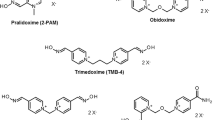Abstract.
Species differences have been observed between hen and human clinical manifestations of isofenphos toxicities. Hens treated with the insecticide isofenphos (90 mg/kg p.o.) developed severe cholinergic toxicity followed by mild organophosphate-induced delayed polyneuropathy (OPIDP). However, a patient developed severe OPIDP, which was preceded by very mild cholinergic signs, after an attempted suicide with a commercial formulation containing isofenphos and phoxim, an insecticide not causing OPIDP (estimated doses were 500 and 125 mg/kg, respectively). To explain this difference the following hypotheses were tested: (1) phoxim is a promoter of isofenphos-induced OPIDP; (2) whereas neuropathy target esterase (NTE) is thought to be the target of OPIDP, activation of isofenphos by liver microsomes causes the formation of more potent NTE inhibitor(s) in humans than in hens; (3) in contrast to hen NTE, the sensitivity of the human enzyme to such inhibitor(s) is higher than that of acetylcholinesterase (AChE), the target of cholinergic toxicity. Results showed that phoxim (22.5 mg/kg p.o.) was not a promoter of OPIDP in hens and that the ratio AChE inhibition:NTE inhibition by microsome-activated isofenphos was similar for both hen and human enzymes. The schedule of antidotal treatment in hens is the likely explanation for the observed difference from the patient. Peak AChE inhibition was maintained in hen brain up to 6 days after a single dose of isofenphos, suggesting prolonged pharmacokinetics. However, the AChE reactivator pyridine-2-aldoxime (2-PAM) was given to hens before isofenphos and then every 8 h, whereas continuous 2-PAM infusion was provided to the patient. When 2-PAM was given to hens every hour after isofenphos (90 mg/kg p.o.), the birds remained asymptomatic. Since other organophosphates may have a prolonged pharmacokinetics, testing procedures for the potential of these insecticides to cause OPIDP may underestimate the risk for humans.
Similar content being viewed by others
Author information
Authors and Affiliations
Additional information
Electronic Publication
Rights and permissions
About this article
Cite this article
Moretto, A., Lotti, M. The relationship between isofenphos cholinergic toxicity and the development of polyneuropathy in hens and humans. Arch Toxicol 76, 367–375 (2002). https://doi.org/10.1007/s00204-002-0352-8
Received:
Accepted:
Issue Date:
DOI: https://doi.org/10.1007/s00204-002-0352-8



